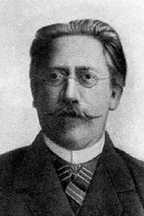Leonard Landois

Leonard Landois (December 1, 1837 - November 17, 1902) was a German physiologist born in Münster.
He studied medicine at the University of Greifswald, and was later a professor and director of the institute of physiology at Greifswald. In 1866 he became a member of the German Academy of Sciences Leopoldina. He was a younger brother to zoologist Hermann Landois (1835-1905) and son-in-law to botanist Theodor Marsson (1816-1892).
His earlier work involved research in the field of parasitology, conducting studies of bed bugs, dog fleas and the parasitic worm Botriocephalus latus. He also conducted studies on the ossification processes that take place in cartilage, tendons and connective tissue. With this instructor, Ludwig Julius Budge (1811-1888), he investigated the phenomena of cardiac arrest during electrical stimulation of the vagus nerve.[1]
Leonard Landois was a pioneer in the study of blood transfusions and the phenomena of agglutination. In 1875 he demonstrated that when red blood cells are taken from one species of animal and are mixed with serum taken from an animal of a different species, the red cells typically clump and sometimes burst (hemolyze).
Selected writings
- Über der Haarbalgparasiten des Menschen (treatise on parasites of humans); (1861)
- Die Transfusion des Blutes (On blood transfusion); (1875)
- Lehrbuch der Physiologie des Menschen (Textbook of human physiology); (1880) Digital 4th edition from 1885 by the University and State Library Düsseldorf
- Die Urämie (treatise on uremia); (1890)
References
- This article incorporate text based on a translation of an article at the German Wikipedia.
- ↑ translated biography @ NDB/ADB Deutsche Biographie
- Colin Wilson, Damon Wilson (2003). Written in Blood. Carroll & Graf Publishers. ISBN 0-7867-1266-X.
|